Iran: 133 people killed in anti-hijab protests after Mahsa Amini’s death
Security forces are accused of gunning down 40 people in one of deadliest reported clampdowns on Friday
Your support helps us to tell the story
From reproductive rights to climate change to Big Tech, The Independent is on the ground when the story is developing. Whether it's investigating the financials of Elon Musk's pro-Trump PAC or producing our latest documentary, 'The A Word', which shines a light on the American women fighting for reproductive rights, we know how important it is to parse out the facts from the messaging.
At such a critical moment in US history, we need reporters on the ground. Your donation allows us to keep sending journalists to speak to both sides of the story.
The Independent is trusted by Americans across the entire political spectrum. And unlike many other quality news outlets, we choose not to lock Americans out of our reporting and analysis with paywalls. We believe quality journalism should be available to everyone, paid for by those who can afford it.
Your support makes all the difference.At least 133 people have died since the beginning of historic anti-hijab protests in Iran, according to a rights organisation, with more than 40 of them killed in a brutal police crackdown on Friday alone.
The protests, sparked by the death of 22-year-old Mahsa Amini in police custody, have led to unprecedented demonstrations against the country’s rigid laws requiring head covering for women.
Women have come out on the streets burning their hijabs and cutting their hair in defiance.
The latest death toll comes from the Oslo-based organisation Iran Human Rights, which has been monitoring the demonstrations since they began in the capital Tehran, where Ms Amini was arrested by the country’s controversial “morality police” on 13 September.
The toll maintained by the organisation stands in stark contrast to the very conservative estimate being reported by Iranian state media, which says 41 people have died, including security personnel. The Iranian authorities themselves have not publicly stated any death toll.
In one of the deadliest reported clampdowns, on Friday, security personnel are accused of gunning down 40 people in just one evening in Zahedan, capital of the southeastern Sistan-Baluchistan province, the rights group says.
The protests have only grown in recent days and spread to more areas, despite the growing death toll. On Monday, security forces clashed with students at a prominent university in Tehran.
Social media videos show security personnel firing teargas shells at the students while some videos also contain distant sounds of firing.
Meanwhile, Amnesty International estimates that at least 52 people have been killed so far, with hundreds injured. The human rights group has alleged that several women protesting against the hijab rule have been sexually abused by the Iranian security forces.
Iran Human Rights says that internet access has been severely disrupted or completely cut in many parts over the last 10 days.
“The killing of protesters in Iran, especially in Zahedan, amounts to crimes against humanity,” Mahmood Amiry-Moghaddam, the director of Iran Human Rights, said in a statement.
“The international community has a duty to investigate this crime and prevent further crimes from being committed by the Islamic Republic.”
Amini, a Kurdish woman, was detained by the controversial morality police unit that enforces the country’s obligatory dress codes for women, including the compulsory wearing of the headscarf in public.
Officials say that she died because of a heart attack three days later while in custody. However, Amini’s family alleged she was assaulted in custody and had visible marks of injury to her body.
Her death has ignited protests against the orthodox rules the Iranian government has been enforcing on women since the Islamic revolution in the 1970s.




Join our commenting forum
Join thought-provoking conversations, follow other Independent readers and see their replies
Comments